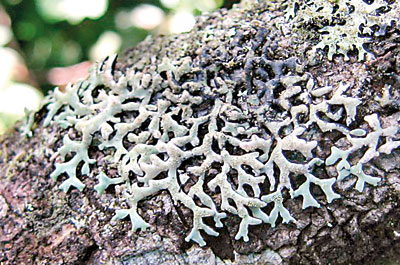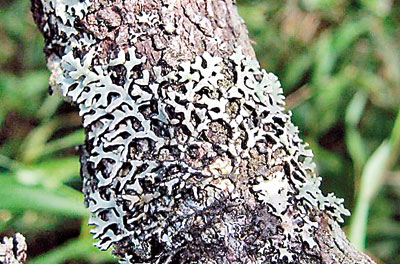Two new lichen species have been discovered at Horton Plains by botanists. Scientifically named Anzia mahaeliyensis and Anzia flavotenuis, these will upgrade the endemic checklist of Sri Lankan Lichens.
A field study on lichen diversity in Horton Plains conducted by Dr. Udeni Jayalal together with Dr. Siril Wijesundara and Prof. Veranja Karunaratne in 2004/2005 under a research grant by the National Science Foundation (NSF) led to this discovery.
 |
| Anzia flavotenuis |
 |
| Anzia
mahaeliyensis |
Dr. Jayalal said they collected over 3000 lichen specimens from different ecosystems of Horton Plains and these were first analyzed considering their morphology or external characteristics. Those that didn’t match with known lichens were sent to the Natural History Museum of the UK for further analysis on molecular characters through DNA tests. The DNA patterns of these two did not match any existing lichens so it was concluded that the researchers had made a breakthrough in discovering two new lichen species.
According to the accepted norm, the researchers were given the chance to name them. Dr. Jayalal wanted to name them after his mentors Dr. Wijesundara and Prof. Karunaratne, but they opted for a more suitable name depicting the characteristics of the lichens and habitats that they were discovered in. One was named Anzia mahaeliyensis from the local name of Horton Plains - “Mahaeliya Thenne” and as the internal parts of the second lichen were yellowish, it was named Anzia flavotenuis, flavotenuis referring to yellow.
Lichens are believed to be one of the oldest organisms colonized on earth. But presently they are threatened due to many factors including pollution and habitat loss. However, little work has been done on lichens in Sri Lanka and knowledge of their diversity and distribution is incomplete. Dr. Jayalal says that presently there are over 600 lichens found in Sri Lanka, but this number can be as high as 1500 pointing to the need to do more studies.
On a roadside rock at Ramboda Pass near Nuwara Eliya, the same group of researchers found another lichen species Lepraria atrotomentosa that had gone unrecognized for years. But sadly this rock has been blasted away during recent road widening. Likewise there could be many lichens yet to be discovered. Lichen is not a single organism the way most other living things are, but rather a combination of two organisms which live together intimately.
Every lichen species is a fungus that encompasses a photosynthesis organism that uses sunlight to produce foods from carbon dioxide and water. Usually the other species is a photosynthesizing alga, but sometimes it can be a photosynthesizing bacterium known as cyanobacteria (neela haritha algae in Sinhala). This is a symbiotic relationship where both fungus and algae need each other for their own survival. Algae provide the food for the fungus and in return the fungi provide protection. Fungi also make a medium to soak up water and nutrients which provide the algae a medium to grow.
The fungus holds the lichen firmly onto the surface on which it is growing. This partnership also allows lichens to grow in harsh environments, at low temperatures and in low light conditions. The main body of lichen is called a thallus. The thallus may be covered by or enmeshed by the fungus. The inner region of an organ or tissue of lichen is known as Medulla. A. mahaeliyensis is characterised by a white single-layered medulla and A. flavotenuis by a two-layered medulla with the upper layer yellow and the lower part white.
“Lichens are good environmental indicators since they are sensitive to pollutants,” points out Dr. Wijesundara. Lichens, unlike most living organisms, are unable to ‘refuse’ entry to many chemicals into their bodies. This means that chemicals can freely invade them and interfere with their metabolic processes, often killing the lichen. However, some species of lichens are tolerant to some pollutants, so by observing the kind of lichens and their prevalence, one can predict about the air quality of the area without sophisticated equipments.
Horton Plains is very rich in lichens, so the researcher suggests this prime ecosystem is still unaffected by air pollution. “We see very few lichens in Colombo and other cities, but their numbers increase as we get to rural areas” Dr. Jayalal says. Lichens have other uses.
There are many dyes, medicines and important chemicals extracted from lichens. Litmus, the colour-changing dye used to make pH indicator paper, is in fact a compound extracted from lichens. While biologists are primarily interested in studying the natural habitat and its organisms, chemists have their eyes on the pharmaceutical value of the organic compounds isolated from natural organisms. Scientific tests have proved there are antibiotic values in these lichanic substances.
Many creatures including squirrels and birds use lichens for cushioning and patching their nests to camouflage them. Moths and butterflies also feed on lichens. |



